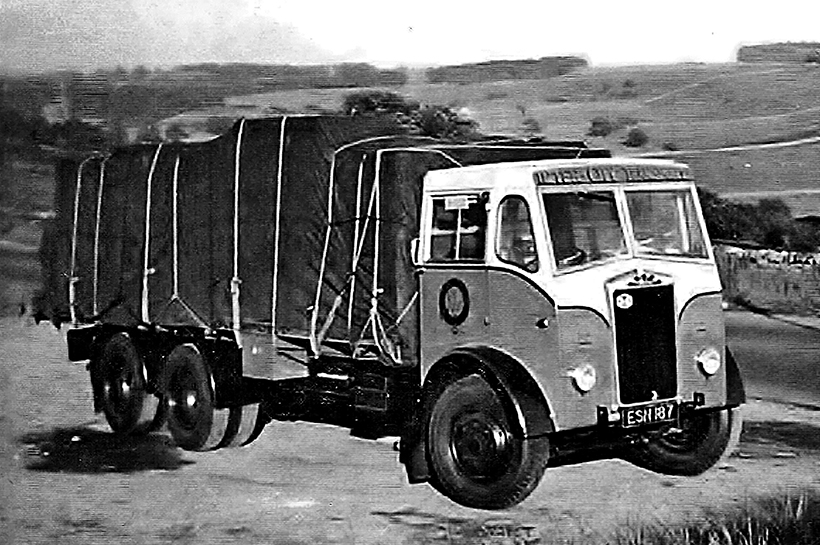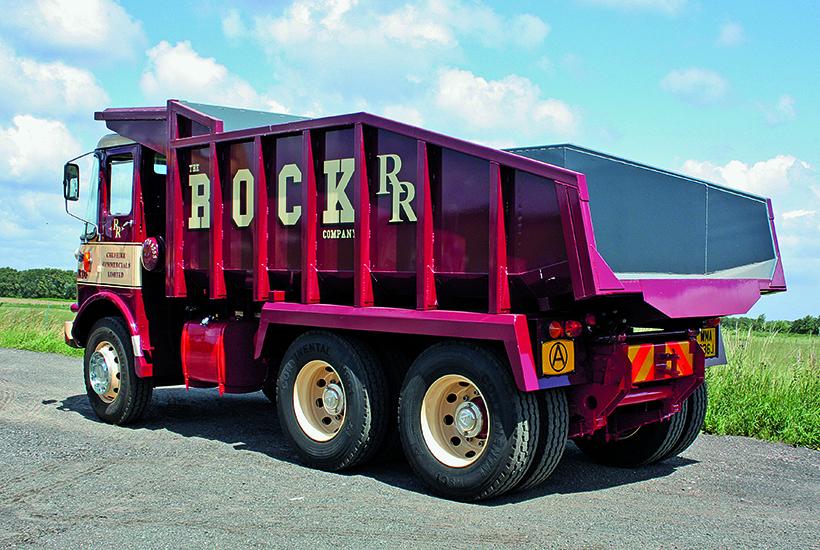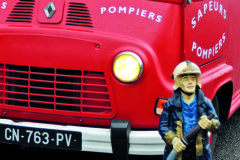1971 Atkinson Searcher reborn
Posted by Chris Graham on 18th October 2020
Rod Richards’ painstakingly-restored and beautifully-presented 1971 Atkinson Searcher truly is a wonder to behold, as Bob Tuck discovers.

Rod Richards’ 1971 Atkinson Searcher is fitted with its original Edbro, front-mounted single ram tipping gear.
You think you’ve seen it all and then, wham, all of a sudden you find yourself looking at something you’ve never seen before. Just where the heck did this come from? Even trying to describe the stunning job Rod Richards has made in rebuilding – or should that perhaps read ‘recreating’ – WMA 836J, leaves you scratching around looking for superlatives.
While the photographs here certainly reflect its stunning appearance, up close and in the metal, the Atkinson just oozes presence, and is so much more than just one heck of a well-done restoration. What’s more, given that Rod did the vast majority of the work himself, the vehicle represents another glittering jewel on this self-taught, workaholic’s hugely impressive CV. Just like the stunning six-wheel scow end dumper he’s produced, his 71 years – and counting – of jam-packed life has certainly been different.

Rod Richards: a master Atkinson restorer.
Inter-City Transport
On paper, Rod hasn’t travelled more than a mile or two from where he was born and brought up which, even now, is more like an oasis of rural backwater, mid-way between the huge urban conurbations of Greater Manchester and the ever-growing mass of Merseyside. This part of the Irlam area is close to the border between Cheshire and Lancashire, and Rod’s early days were spent with a mix of farming and mechanicals – and he proved to be both a natural and a very quick learner at whatever he put his hand to. He also later proved to be quite good at football: “I got a trial for Bolton,” he says and, while he knows he wasn’t good enough to play professionally, he had 35 years of enjoyment playing centre-half for various teams in the area.
On leaving school at 15, an early job was with the well-known Scottish haulier, Inter-City Transport. Although the company’s HQ was in Scotland’s central belt, at Cumbernauld, it had a depot at nearby Lowton – on the East Lancs road – which, as well as storage, serviced the trunk vehicles en-route to the Midlands and London. Coaxing extra running life out of over-worked – and often over-loaded – Albion and Leyland hardware, was what young Rod was introduced to. And he’ll never forget the weight of humping around those huge bottle jacks that became part and parcel of his formative working life.

An early job for Rod was with Inter City Transport. Although having its HQ at Cumbernauld, there was a depot at Lowton. Rod recalls working on Albions and Leylands there. This 1955 Albion is seen when brand new on the A66, cross-Pennine route.
If you listen to Rod talk, you’ll soon discover the amount of drive he still has in him. I naturally asked if he’s now retired from the trade and he says: “Yes… I now only work seven days a week!” I naturally laughed, but it’s was no joke. When he ran his own business, Cheshire Commercials, he worked seven days a week but, in addition, could also work the seven nights in between, as well. Yes, there was no tachograph or hour limitation fitted to the garage clock.
Never being afraid of hard work, Rod recalls being only 19 when he set up his own business as ‘one man and his van – and his spanners’. The commercial vehicle sector was his preference but, during the late 1960s, that world was going through a major upheaval. The new Plating & Testing regulations were introduced, and getting vehicles up to spec’ meant Rod had plenty of motors to go at.
The 1970s were also a time of significant upheaval for the country, with factors such as the three-day-week that was enforced when the country ran out of coal to generate electricity. Rod decided there could be a better life in the Canadian state of Alberta so, with his wife and young family, he decided to make the move there in 1975. Over the following years he worked on Kenworths, Freightliners, Whites and Macks, all of which were being used on the Alaskan pipeline.
However, after 18 months, a bout of homesickness prompted a return to the UK, where he began searching for somewhere for the family to live in again. Of course, a Searcher of a different kind was to find him, too.

This was the condition of the Atky in 2012, when it eventually came off the road. (Pic: Rod Richards)
Muck-shifting
With the current Covid-19 pandemic turning all our lives upside down, it may be quite a while before things like the Heritage Commercial Vehicle Preservation World gets fully back into gear. But, as soon as vehicles start coming out into the daylight, make a bee line to wherever you can find Rod’s Atky. In fact, put such a visit on your ‘must do’ bucket list, as I can assure you that you’ll never have seen anything like it before. Honestly.
Yes, I know this is just an Atkinson six-wheel tipper; so what’s the big deal? But I could hardly take my eyes of it. I kept going round and round just lightly touching it as I thought it might have been a 3D vision which had somehow appeared from Rod’s shed. We’ll come back to Rod’s shed in a minute, because I’m sure the man himself could sell tickets for such a visit if he had the time to talk to one and all about his mind-blowing Gardner collection.
Yes, Rod has loads of them but, before we start on the tale of his tipper, a few bangs on the wall tells Rod his pair of huge horses (a Shire and a Clydesdale) are waiting to go out to pasture: “It’s their daily routine,” he explains as he opens their doors for the daily walkabout.
We eventually get back to talking about the Atkinson, which was new in January 1971. At that time, the Walton-le-Dale manufacturer was giving solid names to its range of vehicles and, of course, the eight-wheeler, rigid ‘Defender’ and the maximum weight 32-ton tractor unit ‘Borderer’, were the cream of the company’s crop, and generated most sales.

About three years ago, someone decided to set fire to the Atkinson. The result was quite a mess, but the vandalism prompted Rod to start the full restoration. (Pic: Rod Richards)
Rod told me the six-wheel rigid 20-tons gross ‘Searcher’ wasn’t a huge seller, but was still available with a few different wheelbase options – a longer wheelbase for general haulage; a medium length for bulk grain tippers etc and then a shorter version for cement mixer applications or muck wagons, like his. “This one was actually one of two that were destined for Northern Ireland,” explained Rod, “but, when the order was cancelled, it was bought by the Macclesfield-based concern of Eric Bailey, who was involved in the construction trade.”
As Rod reminded me, the muck-shifting game is probably the roughest job in the country and, depending on the state of the underfoot quagmire, even double-drive motors like his Searcher might have to be towed both on to and off the site on occasions. The job isn’t easy and, by the time the Atky was about six years old, it was probably already passed its best. But, when bought by Rod’s friend, Seamus Patterson, the tipper then had another 30 years of hard graft ahead of it.
The muck-shifting fraternity is obviously a world of its own. It certainly doesn’t have the image the top-weight, general haulage, long-distance motors enjoy, breezing around the countryside. Normally booked on a day-work basis and generally within a 30-mile radius of home, Rod reckons the Atky could have been one of say 20 other muck-shifters on a site, doing all sorts of stop-start, fetch-and-carry jobs. Not a lot of mileage, but often a lot of weight: “A digger driver would normally fill the body to capacity,” he told me, “and then use his shovel to stamp the load down a few times. That way there was probably room for him to squeeze another couple of bucket loads on top, before the driver was allowed to struggle away.”

Before the engine rebuild began. (Pic: Rod Richards)
Keep things going
Once back in the UK, business life proved a struggle for Rod, who recalls early premises in a brick works at Rixton, where wagons (and farm tractors) were looked after. He was able to expand his business – and employ a couple of mechanics and a garage labourer – by offering a good service. But working all hours, in all sorts of weather, in all sorts of places, meant that the life was anything but easy.
He laughs now, but told me that he wasn’t laughing the night he had to work on an Albion Reiver: “We only had a small shed at the time, and the Albion’s cab was too high for it to drive in, so we worked on it outside. It had to be sorted that night, but we ended up literally frozen to our coats as the temperature fell so far. It was a cold one that night!”
Many mechanics of the time will relate to Rod’s tales of working on his back underneath anything, even on the hard shoulder of the motorway if needs be. That sort of thing doesn’t go on anymore, as today’s breakdowns are more likely recovered to a specialist workshop for repairs.
When he first began trading, Rod took on the name of Rixton Commercials for a short time, and his first wrecker of note was an ex-wartime Scammell Pioneer: “I’m sure it would only do about 18mph, and the local Police barred me from the road because it was so slow. We bought a Foden instead.”

Rod fully restored the Atky’s original 6LX Gardner engine. Here it’s seen ready for re-installation into the chassis. (Pic: Rod Richards)
Rod recalls a time when he had 120 wagons on his books and, in the earlier days, a lot of those were Gardner-powered. Our man was to develop a huge affinity for this engine maker, that had its factory just a few miles away, at Patricroft. Rod now has something like 60 different Gardner engines (there seems more) in his shed; a huge variety of sizes and ages, and the passion he has for every one of these different pieces of engineering history can be seen shining through his eyes. He’s not totally blinkered though because, when I asked him about the best-ever engine in the world, his reply was: “For power and reliability, it must be the 14-litre Cummins – you can’t beat it.”
Rod was to take on the company name of Cheshire Commercials Ltd, and also got involved with buying and selling trucks (ERF in the main). He also spent a few years in haulage – because of customer demand – operating eight-wheeler tippers on specialised waste movement jobs. Yes, Rod would turn his hand to almost anything to make a crust.
One constant to Rod’s varied life was the presence of Seamus’ Atkinson Searcher. Whenever anything broke, fell off or stopped working with it, then Rod and his team had to get it going again. “It was totally abused in the sort of work it did,” admits Rod, “as when it came to us before its annual MoT, we needed to have it for a week just to go through everything and get it sorted.” But, of course, while other wagons came and went, the Gardner-powered Atky just kept going and going – although not forever.

Getting up into the cab is a bit of a stretch compared to, say, the similar-looking Borderer.
Earth, wind and fire
It was about 2012 when, after another accident had resulted in the Atky’s cab getting smashed-up, Seamus decided that enough was enough. But, with Rod not wanting to see it cut up, he brought it back to his place with the intention of (perhaps) bringing it back to life; if he could only find time in his busy schedule to do something. It was only after the Atkinson was deliberately set on fire, about three years ago, that he got the mental push he needed to get the job done.
Of course, standing in the early July sunshine, the finished job looks a corker. Rod has kept as much of the original vehicle as possible – the driveline being original – although he had to find a donor vehicle (a Borderer tractor unit) to source the cab and other things to get the job rolling. To bring that cab up to concours standard, Rod utilised the services of Atky cab specialist, Gary Kershaw, for this demanding job. For (almost) everything else, Rod did the job himself. It was obviously a labour of love to refurbish the original Gardner 6LX engine, which was restored to as-new condition.
One big ‘thank you’ Rod wants us to mention is to the Germany-based Continental Tyre concern: “I managed to find six, brand new Continental tyres of the type I wanted to fit in Reading, but just couldn’t find the four extra I needed to make up a full set. So, I emailed the firm’s head office in Germany, and explained the problem I was having. Astonishingly, the company agreed to make a batch of four tyres, just for me.” He had to wait six weeks for the special order to go through and is well-chuffed about what they did.

The Searcher’s steering wheel and dial set-up is identical to that found in other Atkinsons of this era.
Our man is also more than chuffed how Irlam-based Wyke Commercial Services painted every piece of his vehicle, and applied the final ‘look at me’ graphics. What a finished article it’s proven to be – and don’t you just love the mirror image to the offside name? Magic.
For me, it’s the way the Atky sits – a bit higher than most six-wheelers – and the way it carries that highly distinctive dumper body, that gives it an air of something like panache. Rod recalls the memory of seeing Foden dumpers with that type of body when the M62 motorway was being built, and that triggered the build. And what a great decision that proved to be – eventually. “I was a bit worried when I started to put the body on,” he says, “because I wasn’t sure whether I’d left enough space around the cab, but it worked out perfectly.” You betcha!
After Rod brought the Atky out of the shed, I was keen to try the hot seat but, actually, it’s quite a step up to get in. This deliberately high-positioning is obviously to enhance ground and wheel clearance, and it means you have a good stretch to get up there. But the added bonus is that it also ensures a great driving position.

The traditional open-ended scow dumper was never fitted with a normal type of tailgate to the rear of its body.
It’s no surprise that the Gardner 6LX sounds as soft as you like, as I tip-toe around the Richards estate and, while there wasn’t the room to give the motor its head, the David Brown gearbox felt as good as it gets.
I was never lucky enough to sit inside a brand new Atkinson back in the day, but Rod’s Searcher actually looks, feels, sounds and even smells just as though it’s fresh off the production line. From the moment you open either of the doors – and you hear that wonderful, new hinge creaking sound – to sitting on that brand new seat. And, yes, there’s a slight whiff of recently-applied paint to cement the thought buds. Wow, what a treat this vehicle truly is.
I’ve just run out of superlatives, did I tell you that this is one motor you have to see, hear, touch and even smell for yourself? Your senses will really love it. Honest.
For a money-saving subscription to Heritage Commercials magazine, simply click here

With the vehicle destined to spend a lot of its working time on-site, the Searcher’s cab was built higher off the ground to ensure the best possible ground clearance.





